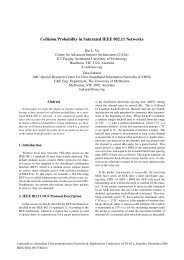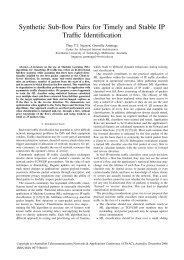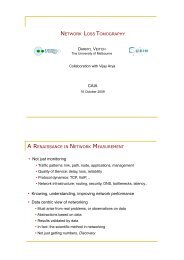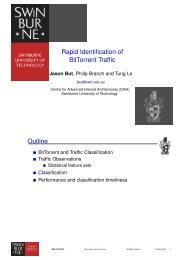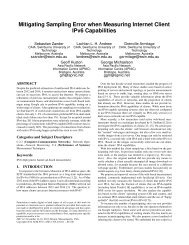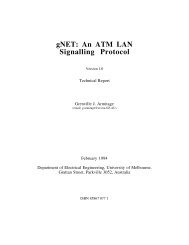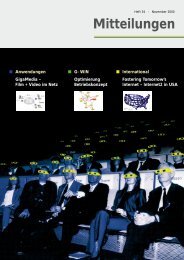Chapter 3 Time-to-live Covert Channels - CAIA
Chapter 3 Time-to-live Covert Channels - CAIA
Chapter 3 Time-to-live Covert Channels - CAIA
Create successful ePaper yourself
Turn your PDF publications into a flip-book with our unique Google optimized e-Paper software.
CHAPTER 3. TIME-TO-LIVE COVERT CHANNELS<br />
Table 3.2: Flows and packet pairs with/without TTL changes and percentage of changes<br />
Flows Packet pairs<br />
No change<br />
(kilo)<br />
Change<br />
(kilo)<br />
Change<br />
(%)<br />
No change<br />
(Mega)<br />
Change<br />
(kilo)<br />
Change<br />
(%)<br />
<strong>CAIA</strong> 128.6 2.8 2.1 1 456.3 340.0 0.02<br />
Grangenet 283.0 8.6 2.9 215.7 62.1 0.03<br />
Twente 1 354.6 24.7 1.8 95.5 74.8 0.08<br />
Waika<strong>to</strong> 1 255.9 57.8 4.4 21.2 86.4 0.4<br />
Bell 899.8 52.9 5.6 36.4 87.1 0.2<br />
Leipzig 7 155.1 429.1 5.7 365.5 1 822.7 0.5<br />
First, packets were grouped in<strong>to</strong> unidirectional flows according <strong>to</strong> IP addresses, port<br />
numbers and pro<strong>to</strong>col (each being a series of packet pairs). We only considered flows<br />
with at least four packets (‘minimum’ TCP flow) and an average packet rate of at least<br />
one packet per second. We extracted the series of TTL values from the IP headers. If<br />
different TTL values occur in a flow or between packet pairs this is referred <strong>to</strong> as TTL<br />
change. Otherwise we refer <strong>to</strong> the TTL being constant.<br />
3.1.2 Amount of TTL variation<br />
Table 3.2 shows the number and the percentage of flows and packet pairs with and without<br />
TTL changes (numbers are rounded). Overall, the TTL is constant for the majority of<br />
flows, but 2–6% of flows do experience TTL changes. The percentage of packet pairs<br />
with TTL changes is between 0.02–0.5%. This shows that if there is TTL variation in<br />
flows, changes occur only for a very small number of the flows’ packet pairs.<br />
3.1.3 Distinct values and change amplitudes<br />
Figure 3.1 shows the cumulative density functions (CDFs) of the number of distinct TTL<br />
values per flow. Most flows with TTL variation have only two distinct TTL values. Only<br />
less than 10% of the flows have more than two values and flows with more than five<br />
different TTLs are very rare, except in the <strong>CAIA</strong> trace.<br />
We examined CDFs of the amplitude of TTL changes of packet pairs, where the am-<br />
plitude is defined as the difference between the maximum and the minimum TTL value.<br />
The amplitude is one for many packet pairs, but in some traces large numbers of packet<br />
pairs have amplitudes around 64, 127, or 191 [9]. The reason for these high amplitudes is<br />
middleboxes, such as firewalls or proxies, (re)sending packets part of the TCP handshake<br />
or teardown on behalf of end hosts (e.g. for SYN flood attack protection).<br />
The TTLs in these packets are set <strong>to</strong> the initial TTL of the middlebox, which can<br />
differ from the initial TTL used by the host. Different operating systems use different<br />
40



